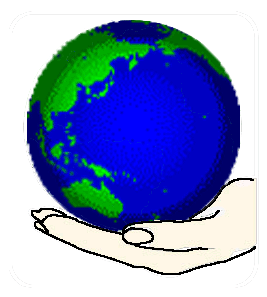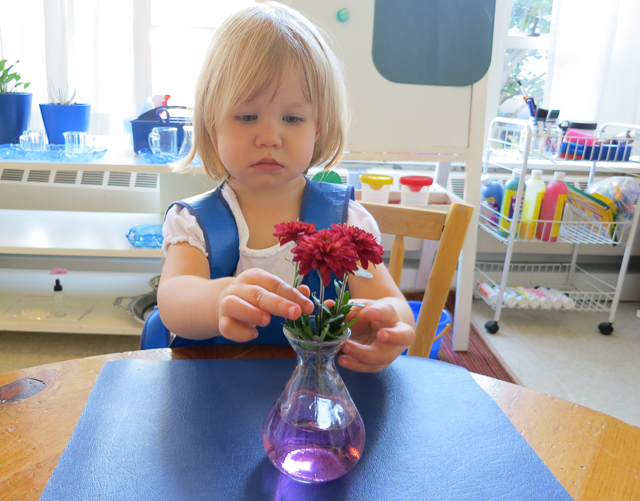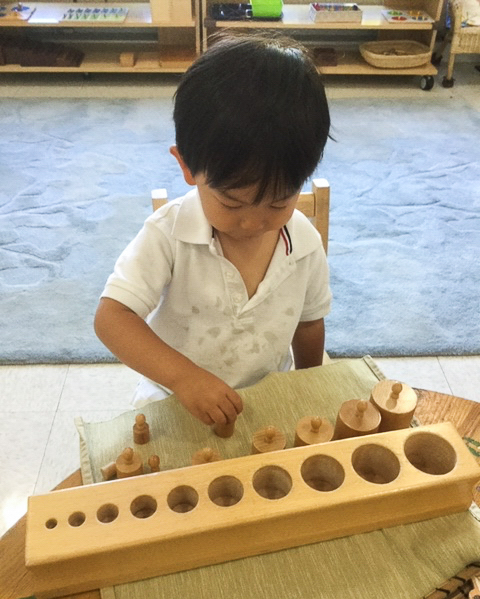

Maria Montessori was born in Italy in 1870. In 1896 she became Italy's first female Doctor of Medicine. She was a devoted scientist and insatiable learner. The fact that she was able to break gender barriers is an indication of the courage, perseverance and determination that characterized her life.
Maria Montessori was a keen observer who, through her study of children as well as through extensive travels around the world, learned that certain phases of development are universal and continue throughout our lives. Children in particular manifest the clearest stages in their development.
Through her work in the fields of psychiatry, pediatrics and education, Maria Montessori developed an approach to education as a means of providing children with the kind of environment from which they would draw what is necessary for the development of they're fullest human potentials. She believed in the uniqueness of each child and in his potential as an architect of a better and more peaceful world.
She continued to observe children around the world and found that the universal laws of development she had recognized were inherent to children of all races and cultures. She addressed the United Nations as a special speaker and guest to promulgate further understanding in human development and education. Considered one of the most predominant figures of the last century, her legacy remains with us to this day.
Dr. Maria Montessori
"If teaching is to be effective with young children, it must assist them to advance on the way to independence
It must initiate them into those kinds of activities which they can perform themselves ... We must help them to learn how to walk without assistance, to run, to go up and down the stairs, to pick up fallen objects, to dress and undress, to wash themselves, to express their needs in a way that is clearly understood, and to attempt to satisfy their desires through their own efforts.
All this is part of an education for independence."
In the first six years of life, a child has a mind that functions very differently from that of an adult, appearing to absorb vast amounts of information effortlessly. Dr. Montessori illustrated the unique mental power of the young child, which enables him to construct and firmly establish within all the human potentiality, and she named this special ability "The Absorbent Mind."
Here is a mind that has a special ability to constantly absorb impressions from the environment, without knowing that it is doing so, like a sponge. The child absorbs his environment so closely that it becomes a part of him. In this way, he accumulates the material from which he will later build up his conscious life, creating the "mental muscles" for what he finds in the world around him.
Throughout her writings, Dr. Montessori placed a great emphasis on the environments in which children live, learn and work. It is this that sets the Montessori philosophy apart from all other methods of education. Traditionally, the classroom is viewed as an area prepared to provide the teacher with elements of teaching and in which a child comes in to follow a routine and curriculum set up solely by the adult. In the Prepared Environment of the Montessori classroom, however, children are free to work and learn. The child engages happily in purposeful activities. Concentration, inner discipline and motivation develop naturally as the children discover and explore this carefully planned environment.
Children work at their own pace, finding attractive activities which are appropriate for their different stages of development. They become problem solvers, leaders, and challenge seekers with a tremendous amount of self-esteem, self-discipline and love of learning.
Children absorb from their environments everything that is part of their culture; they do this without getting tired or fatigued. Learning occurs most fundamentally as a result of interaction with the environment. The teacher is both part of this learning environment as will as the dynamic link between it and the learner.
It is through the control and engineering of the physical properties of the educational setting that the Montessori teacher may have the greatest impact on the students. Her primary mission is to create a safe, beautiful and rich environment where children can learn to master and develop their natural skills.
In her observation of children, Dr. Montessori noticed that as a child develops there are certain periods of time that appear to be the most favorable ones for creating and refining particular human characteristics. She called these special periods "Sensitive Periods," a term borrowed from a biologist. Today, the latest research tends to describe them as windows of opportunity. They are characterized by overpowering, interest and activity toward a particular sensibility. They may result in intense, prolonged activity and always serve toward development and adaptation.
An excellent and extreme example is the Sensitive Period for language acquisition. During the first few years of life, learning to talk and understanding the talk of others can be intense and delightful work as well as a joyous adventure for infants and toddlers. Children will also pass through Sensitive Periods for order, movement, socialization, sensory perception and fine detail.
The Montessori Curriculum
In the Montessori classroom, the space is divided into several logical areas by low open shelves: one for practical Life exercises, one for Sensorial, one for Language, another for Math and other areas for art, music, geography and science.
The Montessori Curriculum is an integrated thematic approach that ties the separate disciplines together into studies of the physical universe, the world of nature, and the human experience. In this way, one lesson leads to many others.
Each material isolates one concept or skill that has been specially designed in a way that children are naturally drawn to want to work with it with little or no nudging from adults. Each material has also been designed so that a child can normally check his own work; we call this a built-in "control of error." The intention of the materials is not to keep the children dependent on these artificial learning aids forever; they are used as tools to help children work and learn at their own pace, to see abstract ideas presented in a very concrete, three-dimensional way, and to help them grasp and understand what they are working on.
Montessori students learn not to be afraid of making mistakes. They quickly find that few things in life come easily, and they can try again without fear of embarrassment.
The Planes of Development
The transformation of children from birth to adulthood occurs through a series of developmental periods.
- The first plane of development occurs from birth to age six. At this age children are sensorial explorers, studying every aspect of their environment, their language, and culture.
- From ages 6 to 12, children become conceptual explorers. They develop new powers of abstraction and imagination and apply their knowledge to further discover and expand their world.
- The years between 12 and 18 see the children become humanistic explorers, seeking to understand their place in society and their opportunity to contribute to it.
- From 18 to 24, as young adults, they become specialized explorers, preparing to take command of their own lives.
For Children under the age of three, there are several Montessori environments:
A Nido, or infant environment, is prepared for children ages two-three months until they are walking well.
The Parent-Infant Class is a setting in which parents and their children, ages two-sixteen months, interact under the guidance of a trained adult.
After they begin to walk, at approximately 12-15 months, children join the Toddler Community where basic motor coordination, independence, and language development are fostered, and individual personality is respected. Rather than a classroom, it is a nurturing social community where very young children experience their first contact with other children and learn to participate in a cooperative group.
Children in the primary program possess what Dr. Montessori called the absorbent mind-the ability to absorb all aspects of one's culture and environment without effort or fatigue. As an aid to this period of the child's self-construction, individual work is encouraged. The following areas of activity cultivate the children's adaptation and ability to express and think with clarity.
Practical Life exercises instill care for self, for others, and for the environment. Activities include many of the tasks children see as part of the daily routine in their home, such as preparing food and washing dishes, along with exercises of grace and courtesy. Through these tasks, children develop muscular coordination, enabling movement and the exploration of their surroundings. They learn to work at a task from beginning to end and develop their powers of control and concentration.
Sensorial materials serve as tools for development. Children build cognitive skills and learn to order and classify impressions by touching, seeing, smelling, tasting, listening, and exploring the physical properties of their environment.
Language development is vital to human development. The Montessori environment is rich in oral language opportunities, allowing the child to experience conversations, stories, and poetry. The sandpaper letters help children link sound and symbol effortlessly, encouraging the development of written expression and reading skills. To further reading development, children are exposed to the study of grammar.
Geography, Biology, Botany, Zoology, Art, and Music are presented as extensions of the sensorial and language activities. Children learn about people and cultures in other count1ies with an attitude of respect and admiration. Through familiarity, children come to feel connected to the global human family. Lessons and experiences with nature inspire a reverence for all life. The comprehensive art and music programs give children every opportunity to enjoy a variety of creative activities, as well as gain knowledge of the great masters.
Mathematics activities help children learn and understand the concepts of math by manipulating concrete materials. This work gives children a solid understanding of basic mathematical principles, prepares them for later abstract reasoning, and helps to develop problem-solving capabilities.
In an exciting research style of learning, elementary children work in small groups on a variety of projects which spark the imagination and engage the intellect.
Lessons given by trained Montessori teachers direct the children toward activities which help them develop reasoning abilities and life skills. The appetite of children at this age, to understand the universe and their place in it, directs the elementary work toward all aspects of culture.
Elementary studies include geography, biology, history, language, mathematics in all its branches, science, music, and art. Exploration of each area is encouraged through trips outside the classroom to community resources, such as a library, planetarium, botanical garden, science center, factory, or hospital. This inclusive approach to education fosters a feeling of connectedness to all humanity and encourages their natural desire to make contributions to the world.
Teachers at Casa dei Bambini

In the "Children's Houses", the old-time teacher, who wore herself out maintaining discipline of immobility, and who wasted her breath in loud and continual discourse has disappeared. For this teacher we have substituted the didactic material, which contains within itself the control of errors and which makes auto education possible to each child. The teacher has thus become a director of the spontaneous work of the children. She is now a passive force, a silent presence.
- Dr. Maria Montessori
The Montessori Method
The Montessori teachers at Casa dei Bambini holds an AMI (Association Montessori International) degree, qualifying them to teach internationally. Beyond their academic accomplishments, these teachers come to Casa dei Bambini for their warmth, commitment to their profession and loving spirit. In addition to being fully qualified and meeting strict state requirements, our teachers' special skills include, but are not limited to, foreign languages, art, music, and various specializing degrees.
In her method, Dr. Montessori envisioned a new role for the teacher. We often refer to her as a guide or director, because the teacher does not teach in the traditional sense. It is the children who teach themselves through activity, while the teacher's role is to direct, stimulate and guide this activity. The students are introduced to materials through careful demonstration, or "presentation." The teacher slowly and precisely uses the material in its intended way while a learner or group of learners watch. During such presentations unnecessary words and movements are avoided and actions are broken into discernible steps to increase understanding and the chance for success when the materials are used later.
The decision to do a particular lesson or presentation often results directly from observations and assessments of other work. The teacher, may then re-present some materials or exercises to show variations or extensions, or to help the student learn new information or terminology. Curiosity and the child's ability to learn effortlessly and concretely allow the Montessori teacher the opportunity to introduce multiple subjects for the child to discover and explore.



